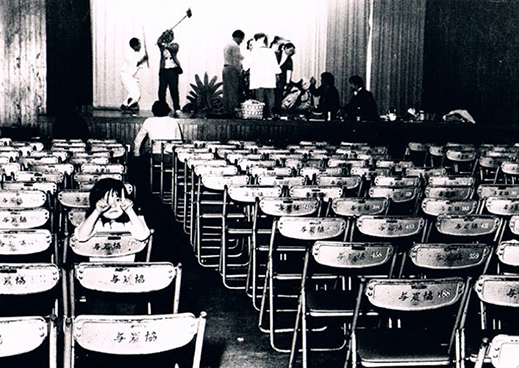 |
Focus features two in-depth reviews each month of fine art, architecture and design exhibitions and events at art museums, galleries and alternative spaces around Japan. The contributors are non-Japanese art critics living in Japan. |
|
|
 |
 |
 |
Around the Stages: Mao Ishikawa and "Sachiko Nakada's Theatrical Company 1977-1991"
Roger McDonald |
 |
 |
Tokyo's nap gallery holds a vintage photo exhibition each summer, and this was the third in the series. Titled The manners of photography #003: Mao Ishikawa, the small but dense show featured Okinawan photographer Mao Ishikawa's series "Sachiko Nakada's Theatrical Company 1977-1991." Ishikawa is a well-known photographer who has exhibited internationally. Born and based in Okinawa, she studied for a brief time with Shomei Tomatsu in Tokyo before embarking on her own path. Her subjects have centered primarily around Okinawa and its people, encompassing not only Okinawans but the American servicemen who are stationed there. This complex and ongoing history has been the focus of inquiry for many artists and photographers from or based in Okinawa, including Yuken Teruya, Chikako Yamashiro, and Toyomitsu Higa. Born in 1953, Ishikawa has developed a personal photographic archive rooted in her strong sense of identity as an Okinawan living amid all of the island's paradoxes and political ambiguities.
 |
Sachiko Nakada is a prominent Okinawan actress and founder of the theater company Deigo-za, which performs folk tales and Okinawan comedy drama. Using the indigenous uchina guchi dialect, Nakada's troupe is a living archive of Okinawan gestures, humor, and time. Ishikawa has spent nearly 20 years photographing the company, both on and off the stage.
The photographs shown at nap gallery were displayed thoughtfully in tight groupings, rather like family albums. Portraits of the actors -- gleaming faces in heavy makeup, after-performance moments of relaxation with children or quiet contemplation -- created a strangely intimate link with something normally public and performed. The sense of a fictional world of costumes and makeup remained constant, but was also made private and familiar through Ishikawa's lens. The volume of the series helped too, by creating multiple layers of time and characters around this most poignant of subjects.
|
| All photographs by Mao Ishikawa, courtesy of nap gallery. |
Perhaps the history of Okinawa is also something at once theatrical and fantastical, subject to the whims of state power and violence, but simultaneously composed of strong personal experiences and voices -- voices that keep telling stories about injustice and loss, but also about the rootedness of something that cannot be easily erased or forgotten. Ishikawa's photographs provide a visual record of these voices: silent images that manage to convey something more than the sum of their parts. We are drawn into her world, and begin to hear other histories about Japan, colonialism, war, identity, hope, and the present.
|
|
|
 |
Mao Ishikawa [Sachiko Nakada's Theatrical Company 1977-1991, A Port Town Elegy 1983-1986] |
 |
nap gallery |
 |
15 June - 11 August 2013
|
|
|
 |
 |
Roger McDonald
Roger McDonald was born and brought up in Tokyo, educated in the UK, and returned to live in Japan in 2000 after completing his PhD. He has worked on the Yokohama Triennale 2001 as assistant curator, the Singapore Biennale 2006 as curator, and organised a number of exhibitions and projects independently. He teaches at Tokyo Zokei Art University and Joshibi Art University. He is the founding Director of Fenberger House in Nagano prefecture, a small private house museum.
fenbergerhouse.com |
|
 |
|